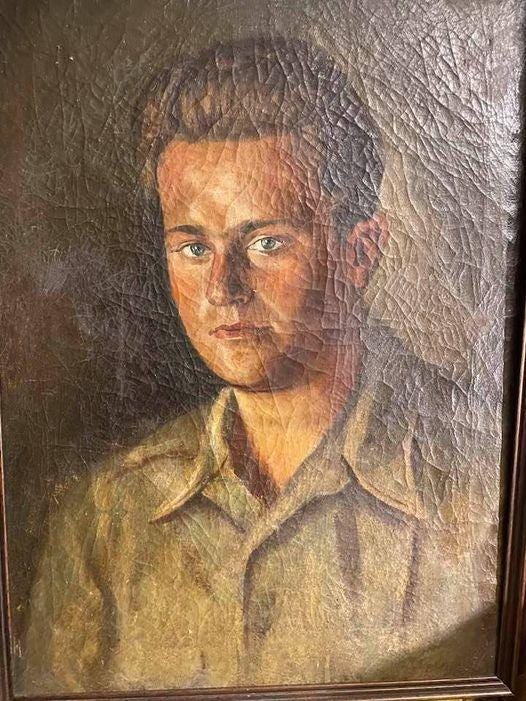War and Peace
(and our shared humanity)
Search the world over, my friends. You’ll never find a portrait quite like the one below.
Yes, I have my own personal “favorites” among Hometown Stories. The following story would certainly rank near the top.
And when you are done reading it, I am hopeful that you might feel much the same.
In World War II, Dad landed on a beach in Normandy, France. Yes, much like in the movie, Saving Private Ryan - but in real life. (If you’ve never seen the movie, then watch at least the first twenty minutes. You will understand. At least. A little.)
When I was a child, Dad only mentioned war to me once. It was when he came home from work one day and found me playing “Army” in the woods at age nine.
My rifle was a stick. I made sure Dad saw me charging up a hill while shouting over at him with exuberant glee, “I’m killin’ Nazis!”
Dad looked sad. (I should note here that Dad rarely looked sad, as he did that day - as he did in the portrait above. I knew him as largely a very jolly and jovial man). So I stopped and walked over to him.
Dad took me aside and told me, “Benny, it’s never any fun when you kill another human being. Somebody’s son or husband. Or somebody’s daddy. Now I’d be proud if you become a soldier someday. Very proud. But you know what? I’d be even more proud if you become a peacemaker.”
As Forrest Gump might say, “That was all Dad had to say about that.”
But Dad did go on to tell me more regarding the unique portrait above. Those particular words weren’t spoken to me until I was age twenty-six, some forty years after this “unique in all the world” portrait was painted. I had just happened to come across it while I was helping Mom and Dad go through some old things. I found it rolled up in the old homeplace attic (I later had it professionally stretched and framed).
Wide-eyed at my discovery, I went straight to Dad. “Please tell me about this.”
Like virtually all soldiers who have seen the horrors of war face-to-face, Dad hesitated to tell me about it. Then he said, “I’ll tell you one time. But just this once. So try to remember.”
Dad didn’t talk long about the portrait. (I feel it is important to again note here that this particular portrait is perhaps the only time I’ve seen any physical representation of him when he was not smiling or laughing. Displaying an almost constant sense of humor evidently became his lifelong “self-medication” for the PTSD with which he surely must have dealt. Back then, soldiers returning from war didn’t receive anywhere near the psychological care they receive today. Thankfully, that has changed somewhat for the better.)
As best I can recall, I will convey his words here. I know he didn’t say much. And I respected his request to not ask him about it ever again.
It seems that sometime after the beach landing (I don’t recall the time frame), Dad was put in charge of guarding some captured German soldiers. One of them told Dad that he had been an artist in civilian life, and that since Dad and those who guarded them had treated them all so fairly (they had been told that if they were captured, the American soldiers would treat them terribly) this man wanted to paint Dad’s portrait.
Dad had been carrying part of a pup tent that had once belonged to a fallen friend. (He said he didn’t know exactly why - but that it maybe helped him go on somehow.) The artist used that pup tent as a canvass (you can tell what it is, even in this pic, by the stretched tent-like texture of the fabric).
The artist fashioned a paintbrush from part of a horse’s tail. The horse had belonged to a fallen German officer, who had been a friend of the artist.
For paint, I can’t recall precisely what was used. Dad told the story only once - and fairly quickly. I do recall something about pigments from the soil and wildflowers - which were surely plentiful on a June day in France.
Leo Tolstoy wrote one of my favorite novels I ever read, War and Peace. I finished it twice - and it is quite long.
Yet my favorite all-time story about war - and peace - was eventually discovered hidden away in the attic of my own childhood home.
Keep reading with a 7-day free trial
Subscribe to Hometownstories.org to keep reading this post and get 7 days of free access to the full post archives.


